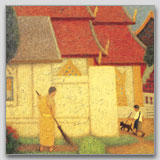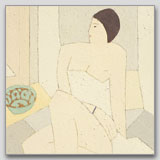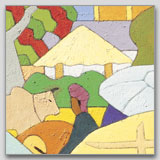| > Living in Thailand Magazine |
| > Rummaging through Drawers |
| Rummaging through Drawers |
| All of us are like pictures that have been edited in Photo Shop. There's the finished image we see there us, but in fact, this image is made up of numberous layers that have been superimposed one on top of the other. Some of these layers are important to the overall impact of the finished picture. Others are smaller, but even so, they affect who we are and remain an integral part of us until the day we die. |
 |
The
various layers that make Muangthai Busamaro who he is can all be
discerned in his paintings.You can see the influence of the CC 80
Club reflected in his fondness for detail. He has a gift for seeing
the beauty in old knickknacks. He knows which bottle of moderately
priced wine to buy. He manages to dress reasonably well without
spending a fortune on clothes. |
He
enjoys listening to jazz and rock and sometimes even takes down
his guitar and jams for hours. When it comes to painting, Khun Muangthai
is a vertable Mr. Encyclopedia, with the names of hundreds, of painters
and their works at his fingertips. On top for aII this, there's
also the Muangthai who's both a typical city slicker and a product
of the rural north. There are traces, too, of his "rolling
family" background and his gift of gab. Finally, as is typical
of someone with a city mole in the corner of his mouth, Khun Muangthai
has a sharp tongue and a strong critical bent. All of these layers
combine to shape the kind of person he is and the art he produces.
Other artists of his generation should recognize his eye for color
and his ability to weigh the elements of his composition and create
a balanced whole. |
That
they only shouldci recognize these gifts is due, to the fact that
for more than twenty years now, Khun Muangthai has been planning
for a solo exhibition of his works, but with the start of the new
millennium already come and gone, his plans for a solo show have
remained just that - plans. As a painter myself working in close
proximity to Khun Muangthai, I can say with some assurace that one
of the main reasons for this is that he's ae perfecfionist. Khun
Muangthai doesn't want chance to play any part whatsoever in the
success or failure of h s work. He's constantly painting over parts of his canvas, changing the omposition, or editing out the smallest details that just don't sit right with him. I remember one of his largest canvases, a bold work with brilliant colors arranged in geometric shapes and done with a whole range of painting techniques. Over top of this he had painted the face of the Buddha in the very center of the canvas. Finally finished, he took one long, last contented look at the painting before heading off for bed. |
But then bright and early the next moring, he was at it again. He removed the Buddha's face and made several changes to the overall color scheme. I couldn't help but wonder - is this any way for an artist to work? Even so, I have to admit that Khun Muangthai was born to paint. He has the critical eye and the manual facility of a true artist. As a result, many of his fellow painters have had one or even more than one solo exhibition, while we've had to wait for Khun Muangthai to enter what I like to call his post-perfectionist phase to have his fist solo show. To understand how the works in the show will be received, maybe the conversation I overheard the other day will give some indication. |
 |
Mr. E : Khun Muangthai doesn't fool me. Whether he's painting temples, or flower, or women, the subject matter doesn't really seem to have any meaning for him. All right, the women he paints may be fleshy and sensual, and his temples may reflect the Lanna style, but what seems to matter to him is the use of color as the dominat structuring element in the work. He's obviously someone who likes to heat things up. Look at the palette in each of the paintings.It's as though he's pushed up the intensity of the color. Here we have the hot season, and over there the cold season. Everything is pushed to the limit. Some of the pictures are like listening to cool jazz. It's as though he were taking us to some distant star or some faraway country where color rules. Mr.
M : I'm afraid that the way of looking at Khun Muangthai's
paintings - focusing on theory and ignoring the subject matter
- takes all the fun out of them. Mr. E : Oh, no! Not again! I can't tell you how many times I've heard that kind of analysis before. It's the kind of analysis that can be applied to almost any type of painting anywhere in the world. Granted, there are paintings intended to reflect the dichotomy you're talking about, but it doesn't seem to me that that is Khun Muangthai's primary concern. I still think that what he's trying to do is to take us inside some sort of hothouse of color. Just look. Some of the canvases have a coarse texture, like sand embedded in a layer of pigment. Others have this flashy quality, like the creamy frosting on a birthday cake. Doesn't that prove to you that what the artist is up to is raising the temperature on us, getting us as hot under the collar as he possibly can? I tend to see Khun Muangthai's works from the perspective of an engineer, rather than a storyteller. Mr. M : But that way of looking at paintings - focusing solely on the technical aspects - is hardly new either. The Reborn 80 group, for instance, explored painting from a strictly technical point of view, applying paint to their canvases in any number of ways. I'm sure that Muangthai Knows all about their experiments since I've heard that he's quite an expert on contemporary painting. That's why I insist that you can't overlook the subject matter of his work. Several of his canvases reflect current trends, but personally I prefer the pictures of northern-style temples. These are the paintings that depict a particular place.They help to explain why foreigners see Chiang Mai, Burma and Luang Prabang as special. It's because of the simplicity of the way people live in these places. It's a simplicity that you only find these days in Third World countries in Asis, Africa and Latin America. Capitalism hasn't turned life into such a struggle there. Khun Muangthai's paintings of village life are expression of this simplicity Mr.
E : Hold on. I want to go back to the business about
the Reborn 80 group. All right, they were trying to push painting
to its limits. But if you look at things from a more mature point
of view, it seems to me that it isn't a question of what's in
style and what isn't these days.Instead, there are these different
poles and artists need to decide where they stand in relation
to them.This is the golden age of choice, and here we are in a
giant supermarket.We just need to have confidence in the choices
we make. We're free to re-engineer or recycle. But as for Khun
Muangthai, he seems to take an approach that I want to call "screen
on screen." |
 |
This
is my explanation - and it's not that I want to praise him - it's
that he's trying to compensate for what he didn't have when he was
a child. A long, long time ago, he used to bum cigarettes off me,
and from time to time, I'd lend him some money. |
Mr. M : What does that have to do with anything? If Khun Muangthai were to hear you talking about him like that, he'd probably give you a good swift kick. Mr.
E : No, no, no. I don't want to insult him. All want
to do is make the point that it's because of his unhappy childhood
that he approaches painting from the perspective of a structural
engineer.No matter what the current fashion is, this need to create
structure is always more important. Mr. M : Is he kidding himself? And you - you sound like one of those Freudian analysts. Why don't you go back even further into the past back to the time when his mother was still breastfeeding him? Mr. E : Don't be ridiculous. Is that the way you understand what I've been trying to say? Give me a little more credit than that.If what I'm saying is true, then things can't be very easy for Khun Muangthai.As a color engineer, he's always seeing how far a particular style or form can take him. Mr. M : All right, I understand. But this whole business of content - I still disagree with you. You know, he and I both took part in the antigovernment demonstrations in May 1994. |
This
is just part of the argument over Khun Muangthai's works. Which
point of view more accurately reflects his approach to painting
is hard to sy. In any case, it's safe to say that this one
man show marks an important step forward in Khun Muangthai's career
as an artist. And I sincerely hope that it enriches both his pocket
and his reputation. Best of luck! |
With
Iove and friendship, |
| Back to Top |